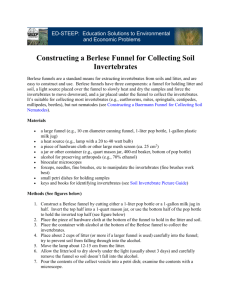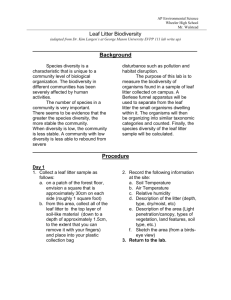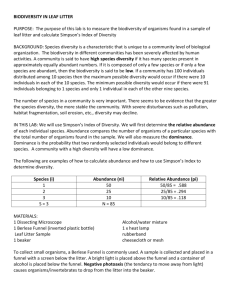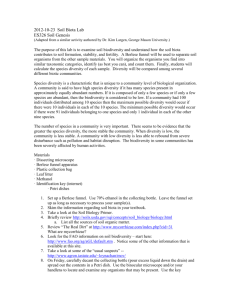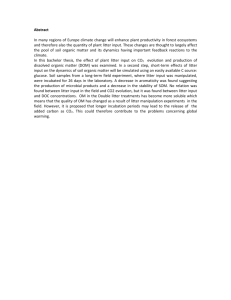The Berlese Funnel
advertisement
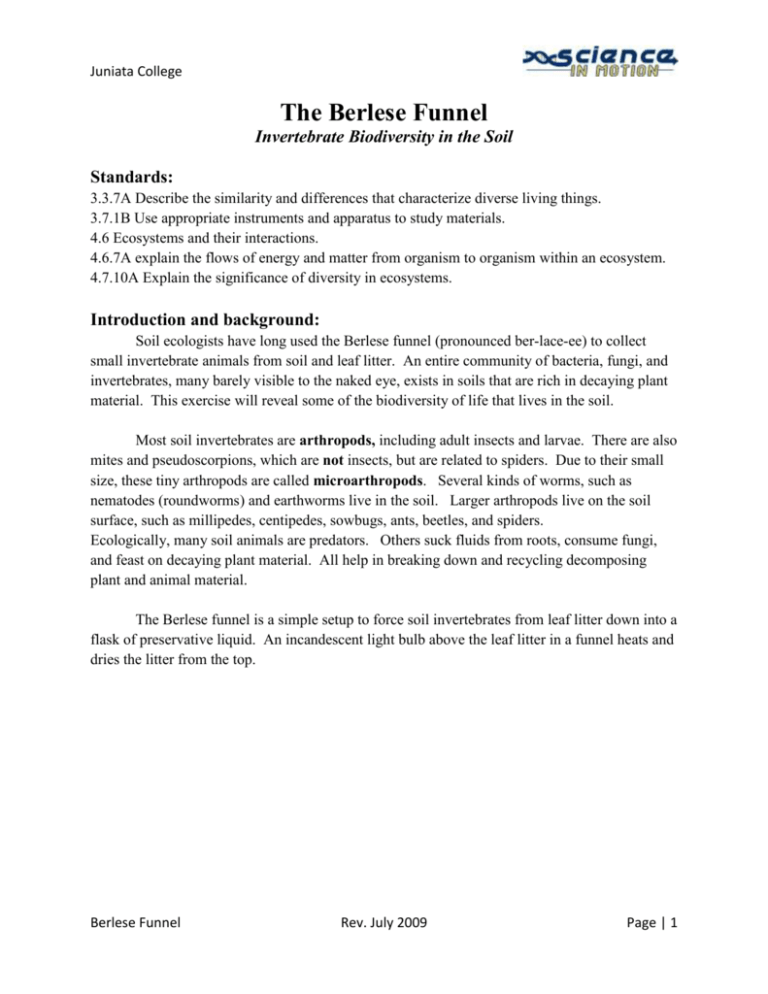
Juniata College The Berlese Funnel Invertebrate Biodiversity in the Soil Standards: 3.3.7A Describe the similarity and differences that characterize diverse living things. 3.7.1B Use appropriate instruments and apparatus to study materials. 4.6 Ecosystems and their interactions. 4.6.7A explain the flows of energy and matter from organism to organism within an ecosystem. 4.7.10A Explain the significance of diversity in ecosystems. Introduction and background: Soil ecologists have long used the Berlese funnel (pronounced ber-lace-ee) to collect small invertebrate animals from soil and leaf litter. An entire community of bacteria, fungi, and invertebrates, many barely visible to the naked eye, exists in soils that are rich in decaying plant material. This exercise will reveal some of the biodiversity of life that lives in the soil. Most soil invertebrates are arthropods, including adult insects and larvae. There are also mites and pseudoscorpions, which are not insects, but are related to spiders. Due to their small size, these tiny arthropods are called microarthropods. Several kinds of worms, such as nematodes (roundworms) and earthworms live in the soil. Larger arthropods live on the soil surface, such as millipedes, centipedes, sowbugs, ants, beetles, and spiders. Ecologically, many soil animals are predators. Others suck fluids from roots, consume fungi, and feast on decaying plant material. All help in breaking down and recycling decomposing plant and animal material. The Berlese funnel is a simple setup to force soil invertebrates from leaf litter down into a flask of preservative liquid. An incandescent light bulb above the leaf litter in a funnel heats and dries the litter from the top. Berlese Funnel Rev. July 2009 Page | 1 Juniata College Vocabulary: Arthropod a phylum of animals that have jointed legs and external skeletons. Insects, spiders, lobsters, crabs, and shrimp are among the many kinds of arthropods. Microarthropod. Microarthropods are soil and leaf litter arthropods. They are less than 2 mm in size, and include mites, pseudoscorpions, springtails, and small primitive ubsects. Trophic level (note the diagram above) Species that occupy the same level (such as decomposer, top predator, etc.) in the food web. Mite. A microarthropod arachnid with 8 legs and usually a globular body. Soil mites are predators, graze on roots, or feed on fungi. Springtail. A primitive, wingless insect that can jump by rapidly forcing its tail downward. Most springtails live in the soil and feed on fungi. Materials: 100 mm plastic funnels, stoppers, and wire screens) 50 mm on a side square-sided glass jars (7) Calipers graduated in mm (7) Plastic forceps (7) Lamp stands w/40 watt bulbs (7) 50:50 ethanol-water mix Safety: Wear safety glasses when using alcohol. Keep the light source away from the alcohol Procedure: 1. Obtain a leaf litter sample from a site by scooping the litter from the soil surface. Dig only into the crumbly top layer of the soil. Place about 500 cc of litter into a sandwich bag. Seal the bag and label it with place and date of collection. If processing is delayed overnight, store in a refrigerator (not the freezer!). The instructor may possibly provide the leaf litter for the lab. 2. Pour about 25 ml of the 50:50 ethanol/water solution into the flask or bottle. 3. Fit a piece of the screening material into the bottom of the funnel. Tape the sides of the screen if necessary, so that the leaf litter does not fall into the preservative. 4. Place the funnel into the neck of the square-sided bottle. 5. Carefully put the leaf litter sample in the top of the funnel. Place a lighted 40 watt lamp above the funnel with the incandescent bulb about 1-2 inches from the top of the leaf litter. 6. Leave the lighted setup on the lab bench for a week or the length of time the instructor tells you. Berlese Funnel Rev. July 2009 Page | 2 Juniata College 7. Examine the preservative solution each day and count the number of invertebrates that have fallen into it. 8. At the end of the experimental period, break down the Berlese setup and transfer the preservative solution – or part of it – to a Petri dish. Examine under a dissecting microscope. There will be some fine debris mixed with the invertebrates, so poke around with a pencil or probe to see the organisms better. 9. Now try to identify the main groups of invertebrates. Most will be insects or other kinds of arthropods. You will probably see mites, springtails, and other primitive wingless insects, small beetles, and nematode worms. There may be a few pseudoscorpions with large pincers. Use the handout entitled Common Soil and Leaf Litter Organisms to help identify what you see.. 10. Note: the Berlese funnel method depends on heat and desiccation to force the organisms down through the leaf litter and into the preservative jar. Many of the worms (they dry up rapidly) and insect grubs (slow movers) will not be captured. The larger centipedes, millipedes, spiders, ants, and beetles may not get through the screen. You will mostly see the smaller, more mobile species. Diagram I. Berlese Funnel Rev. July 2009 Page | 3 Juniata College Berlese Funnel Rev. July 2009 Page | 4 Juniata College BERLESE FUNNEL WORKSHEET Names/s_______________________________________________________________________ Date______________ Period_____________ Answer the following questions about this lab assignment. 1. Would you capture many invertebrates with the Berlese setup if no lamp or other light or heat source was used? Explain your answer. 2. Count the total number of organisms visible in the preservative solution each day. Day 1 Day 2 Day 3 Day 4 Day 5 Day 6 Day 7 Number Of Organisms 3. What day had the largest increase in number of organisms? What does this say about the rate the organisms migrate through the leaf litter? Berlese Funnel Rev. July 2009 Page | 5 Juniata College 4. Randomly select ten organisms in the petri dish and identify each of them as closely as you can. You will want to use a dissecting microscope for most. Measure the length of each organism with calipers. Fill out the table below. Kind of Organism. Length in mm Brief Description of organism 1. 2. 3 4 5 6 7 8 9 10 5. What kinds of organisms are most common in leaf litter? 6. What is the size range of organisms that you measured? What kind of organism is largest? What kind is smallest? Berlese Funnel Rev. July 2009 Page | 6
